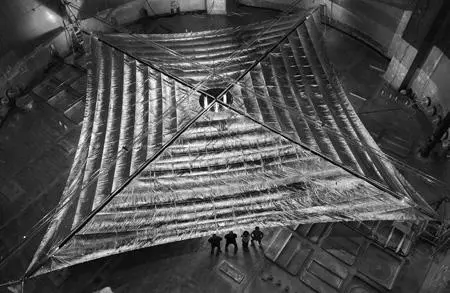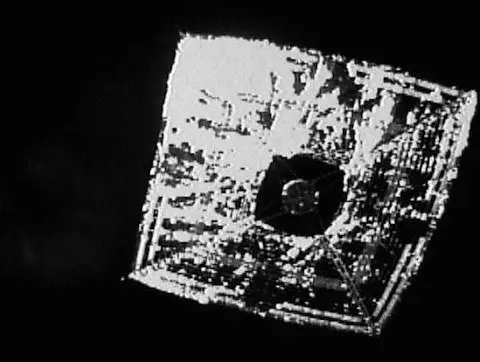In this case, the space shuttle engine is the hare and the solar sail is the tortoise. Chemical rockets will never take us to the stars, but solar sails might. It is important to note that while solar sails may one day take us to Alpha Centauri, they will never get us off the surface of the Earth. To lift from the surface of the Earth, we need a propulsion system that can produce more thrust than the rocket weighs. Chemical rockets are capable of producing these high thrust levels; solar sails cannot.
Before we start building our solar sail-propelled starship, we need to discuss a few more critical issues that will affect our design. First of all, the sail will still be subject to Newton’s Second Law, which states, “a body of mass (m) subject to a force (F) undergoes an acceleration a that has the same direction as the force and a magnitude that is directly proportional to the force and inversely proportional to the mass.” In other words, to get a mass to accelerate, we need to apply a force. In order to get the accelerations needed to achieve very high speeds, such as those required for interstellar travel, we need a large force or a small mass, or in this case, we need both.
Newton’s Second Law requires our solar sail design to be very large so the sail can capture as much sunlight as possible in order maximize solar photon thrust. It also requires us to use very lightweight materials so that we can make our ship as low mass as possible. The sail must also be highly reflective so that we can capture as much momentum from each photon as possible.
Is there anything we can do to increase the force acting on the sail from the sunlight? Even though we have the benefit of time, five pounds of thrust per square mile is ridiculously small. We would require a sail almost one hundred thousand square miles in area to equal the thrust produced by one space shuttle engine. Such a sail would have roughly the same surface area as Alabama and Mississippi combined! Surely we can do something to increase our thrust so that we can make a smaller sail.
It turns out that another interesting fact about sunlight allows us to do just this. We can dramatically increase the force acting on the solar sail by flying closer to the Sun thanks to a property of sunlight called The Inverse Square Law. According to this law, if we move an object twice the distance from the light source, it will receive only one quarter of the illumination. Two times the distance (2) means one-fourth (¼) the illumination—two squared is four. If we move out to four times the distance from the Sun, the illumination drops to one sixteenth of the previous amount—four squared is sixteen. Less illumination translates directly into less force. Fortunately, we can use this geometric property to our benefit by moving closer to the Sun. If we reduce the distance to ½ its previous value, we get four (4) times the force. If we reduce it to one fourth, then we get sixteen times the force. And if we get sixteen times the force per square mile, then we can reduce the overall surface area of the sail by the same factor. And when we are talking about sails the size of US states, a factor of sixteen is significant.
This all sounds great, but are solar sails real? Have they been built and tested in space? Has anyone actually used one for sending a spacecraft anywhere? Yes, yes, and yes!
Until the 1970s, Kepler’s vision and Compton’s physics were good science but for space travel they were primarily an intellectual curiosity. With the anticipated return of Halley’s Comet in 1986, NASA commissioned a study of the feasibility of using a solar sail to rendezvous with the comet. The project never got off the ground, but it did get many space scientists and engineers thinking about solar sailing as something real, and the pace of sail technology development accelerated. The first big step was taken by Russia with the launch of their Znamya mirror in 1993. Znamya was a large, lightweight mirror flown in space to test the idea of using reflected sunlight to illuminate large areas on the ground at night. The mirror was made from very lightweight reflective materials and looked, for all practical purposes, like a solar sail.
In the late 1990s, the Europeans entered the picture with the ground-based development of a one hundred foot sail manufactured by the German company DLR (Deutschen Zentrums für Luft- und Raumfahrt). Though the sail never left the laboratory, it inspired NASA to develop a similar capability during the early 2000s that culminated in the testing of two different solar sails in the world’s largest vacuum chamber, which is located at the NASA Glenn Research Center’s Plumbrook Station. The two solar sails were one hundred feet in diameter, made from materials thinner than a human hair, and autonomously deployed under space vacuum conditions to test their space worthiness. Figure 5 shows the sail developed for NASA by L’Garde, Inc. just after a deployment test in the vacuum chamber.

Figure 5. NASA and L’Garde, Inc. tested a 100-foot diameter prototype solar sail in the mid-2000’s. Shown in the picture are the fully deployed solar sail and with four of the sail engineers standing in the foreground to show scale. (Image courtesy of NASA.)
Japan took the next major step in solar sailing by actually flying a sail in space and using it as a primary propulsion system. The IKAROS (Interplanetary Kite-craft Accelerated by Radiation Of the Sun) was launched in May 2010 on a trajectory that will take it on a voyage near Venus. Though smaller than the NASA and DLR ground demonstration sails, the sixty-five foot diameter sail showed the world that solar sails can be used in space for propulsion. Figure 6 shows the IKAROS in space after deployment.

Figure 6. The Japanese Aerospace Exploration Agency launched the IKAROS solar sail on a mission to Venus in 2010. Shown in the figure is an actual picture of the IKAROS sail after deployment taken by a small robotic camera ejected from the spacecraft during flight. (Image courtesy of the Japan Aerospace Exploration Agency.)
In 2010, NASA launched the NanoSail-D into low Earth orbit. NanoSail-D, (where D stands for drag ) is not a functioning solar sail since it is not using the force of sunlight in a controlled manner for propulsion. The ten-square-foot NanoSail-D might instead be a space demonstration of more conventional windsailing. As NanoSail-D skimmed through the Earth’s uppermost atmosphere, the wind created by its passing caused the spacecraft to slow and eventually re-enter. The wind caused drag, giving NanoSail-D its name.
Other groups are planning small sail missions that will actually use sunlight pressure for propulsion. Chief among them is the Planetary Society’s LightSail-1. Similar in weight to NanoSail-D, LightSail-1 will have a sail three times larger and be capable of pointing toward the Sun in order to use the sunlight for propulsion. CU Aerospace and The University of Surrey have similar sails in development.
Following the successes of IKAROS and NanoSail-D, there has been renewed interest in solar sailing, and several countries are considering the development of even more ambitious sails for use in missions throughout the solar system. We have a long way to go, however, before we will have a sail that can be used to send a spacecraft beyond the edge of the solar system into the abyss between the stars.
Some may be wondering how a solar sail, which derives its thrust from sunlight, can possibly take a spacecraft from one solar system to the next. After all, sunlight gets rather dim and is almost nonexistent when we get beyond the orbit of Pluto—let alone when we are in true interstellar space. Without sunlight, there is no force acting on the sail, hence no acceleration. So, how can it be done? There are two answers: 1) solar sails with very close solar approaches and 2) laser-augmented solar sails.
Читать дальше














